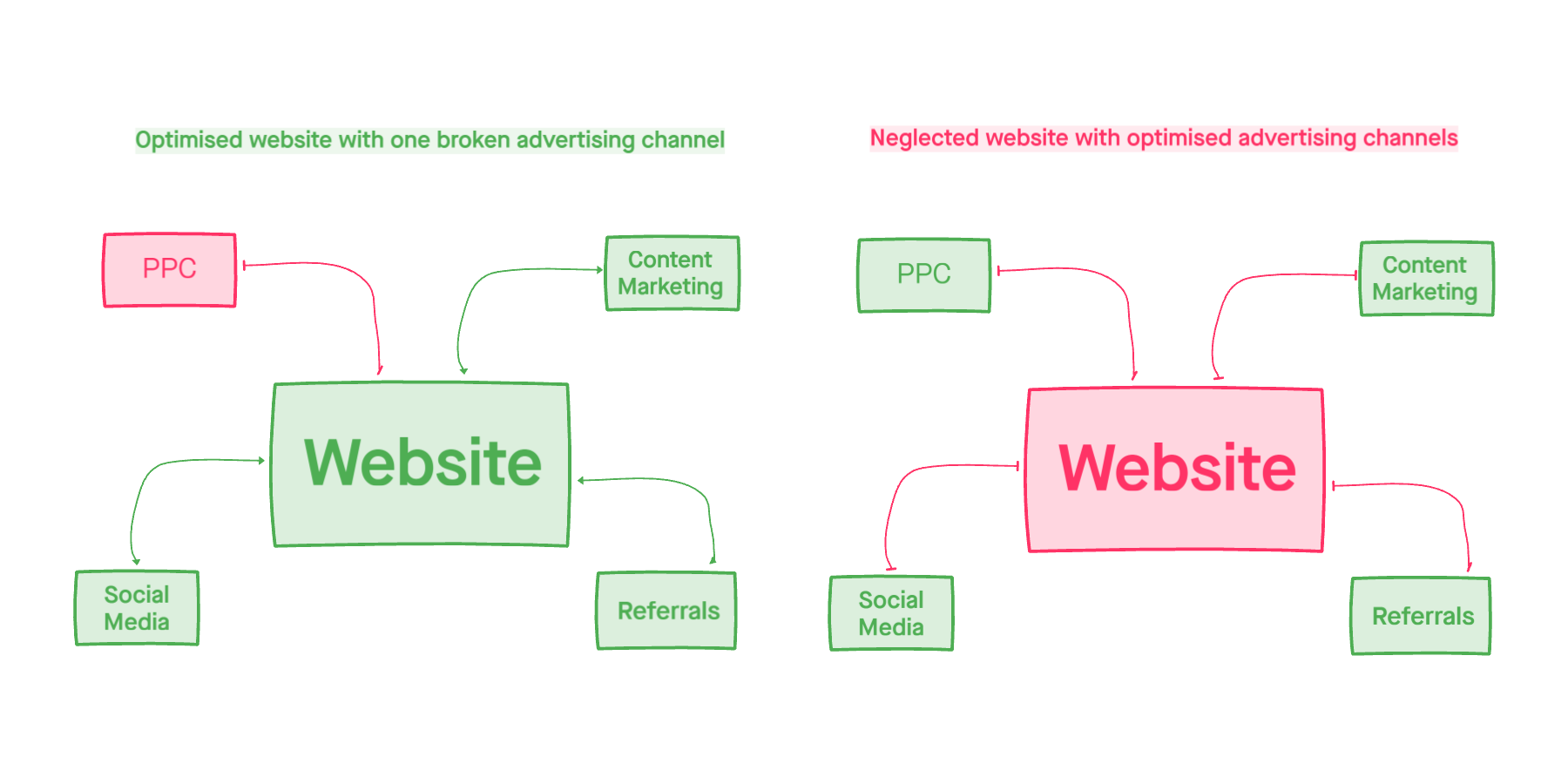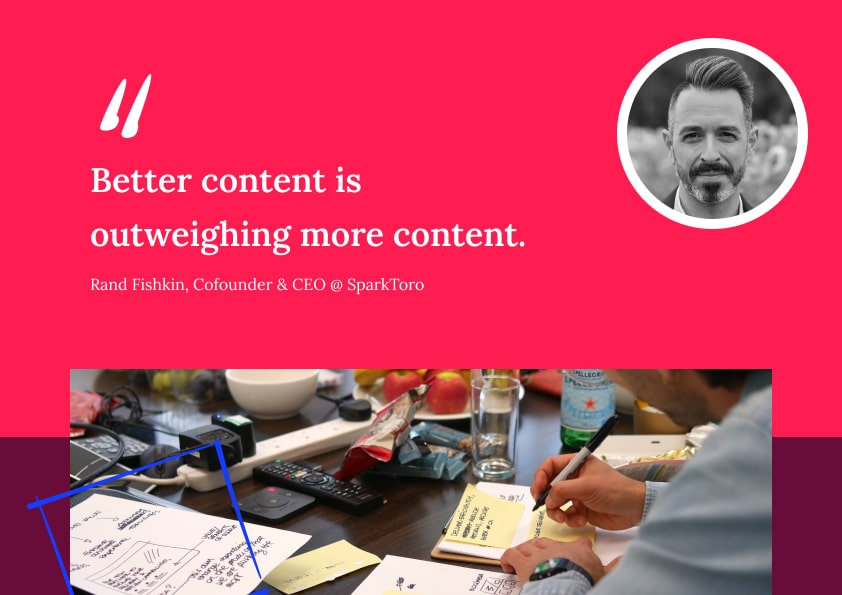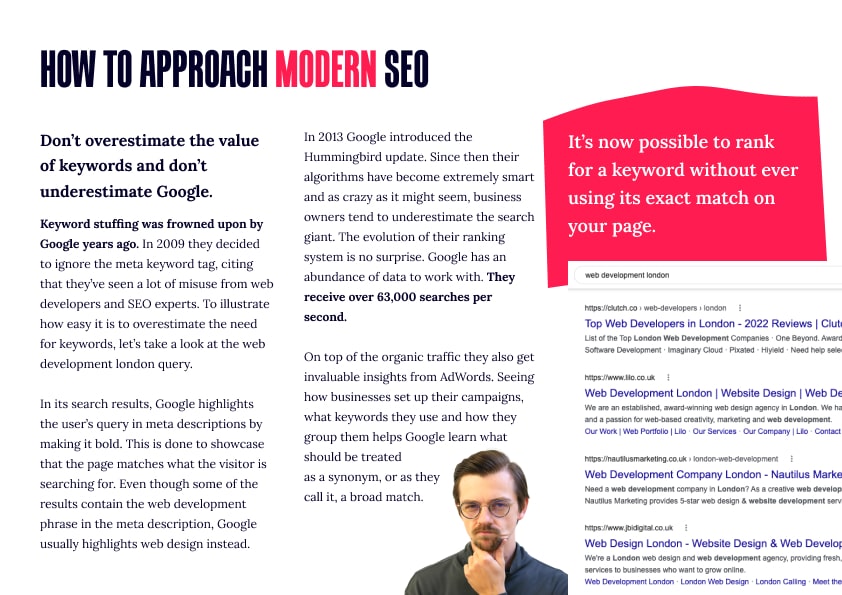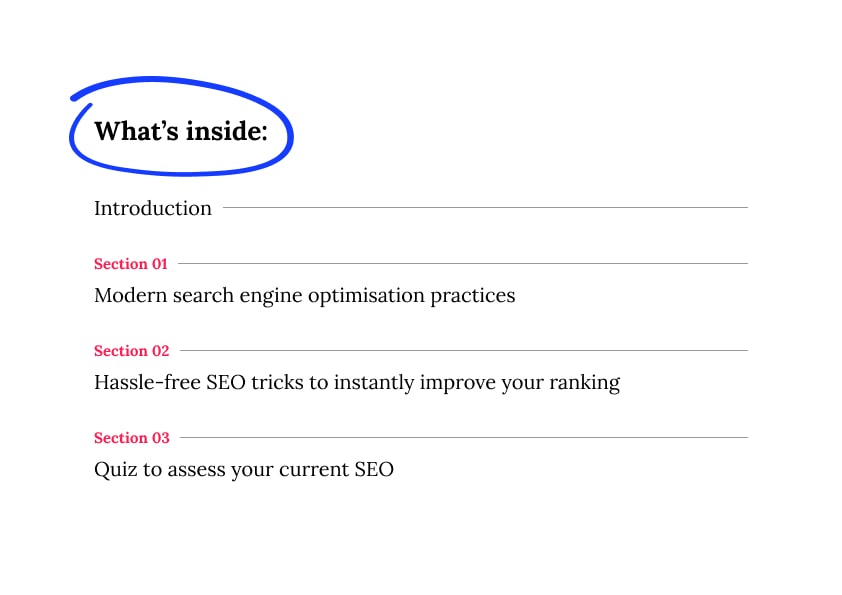Why digital marketing fails – the biggest reason that nobody mentions
The list of reasons for digital marketing failure is considerable. And since we all learn through failure, as a digital marketer you probably know most of them by heart. Whether you’re looking for the reason your latest campaign didn’t deliver, trying to make the next one even better than the previous, or preemptively learning about them before your next big project - you’ve heard it all. But nine out of ten times, the most important reason is left out. That reason is your website. Written by Dawid ZimnyAccording to the CMO Spend Survey by Gartner, on average 10.4% of yearly marketing budget is spent on website design and optimisation, with leaders spending considerably more.
In the midst of planning ad spend and brand-new creative campaigns, the backbone of digital marketing often becomes an afterthought.
Why is my digital marketing failing?
Identifying why your campaigns are underperforming is crucial. Getting it wrong is just as costly as making the mistake in the first place, increasing its consequences exponentially. But most of the time, marketers are told to look in the wrong places. Many suggestions list low-level mistakes as the ones to look out for:
- inaccurate user research
- poor understanding of your competitors
- inability to communicate your value proposition
- lack of automation
- measuring the wrong KPIs, or not measuring at all
- a disconnection between marketing and sales
- delivering content at the wrong stage of the customer journey
- working on a hunch rather than accurate data
All these aspects are important, but they shouldn’t be the first thing you investigate. On the surface, they present a logical thought process. You’ve started a campaign and these are some key tasks when executing your strategy. But we need to go “upstream” first.
What is the goal of my digital marketing campaign?
Most of the time, the answer will be:
- generate more leads or enquiries on my website
- sell more products on my website
- increase brand awareness by showcasing my business website
Can you see the pattern here?
Website is the common denominator.
It’s the fundamental layer of any digital marketing campaign. When it fails, it’s virtually impossible to say if your other efforts were worthwhile. You could prepare the best campaign ever, but since you overlooked the opportunity to improve your website first, it will underperform and fail.
Your site is the key to achieving your digital marketing goals. But “a goal without a plan is just a wish”, and a business website is a critical part of your plan.
“A goal without a plan is just a wish”
Antoine de Saint-Exupéry
Think about it as if you were cooking. You can throw exceptional ingredients together and have an okay meal. If you try improving it by exchanging or removing some ingredients, you may or may not succeed.
But once you follow a recipe, it will bring the best out of your ingredients (in this case, the likes of social media and PPC) and you’ll know which ones to use. You can then adjust the recipe to fit your taste, manipulating the ingredients to achieve the desired goal.
If your audience can’t make sense of their ultimate destination, your website, they won’t convert. But does this mean there was a problem on their way to get there? Not necessarily. And in that case, similarly to cooking without a recipe, you can’t attribute that to a mistake made during the advertising process.
Why is a website important for digital marketing?
If you had a physical store in the centre of London and ran an unsuccessful ad campaign, you’d record a loss on the campaign. Regardless, the passersby will still shop at your store, ensuring your business stays profitable.
When you translate that to the digital world, there are even more entry points. You “lose” the physical location, but gain the digital presence in organic searches. You can promote your business by running paid advertising in search engines and on other platforms, creating social media and content marketing campaigns, driving traffic from referrals and traditional marketing, and more. If one fails, the rest remains unaffected.
With one exception – your website. If your website fails, all of your efforts will be in vain. You can compare it to permanently closing your store as a brick-and-mortar business but still spending money on advertising it.

How your website and marketing work together
We’ve established that your website should always be number one on your marketing priority list. But what can you do to ensure it supports your marketing team? Can you give your marketing campaigns a boost without increasing the ad or campaign budget?
The answer is yes, and here’s how.
Google ranks your site based on User Experience
UX is slowly becoming a buzzword. Digital agencies often use it to market their services without fully understanding it – and since you’re here, it’s likely that it has happened to you.
So why exactly do we say Google ranks your site based on UX? As a complex subject, user experience covers everything, from content relevance to technical aspects. It’s not because UX gained in importance – it was always just as significant. Instead, search engines can now reliably tell which website the user prefers without having to resort to trivial word counts.
In a 2019 survey among SEO experts, user experience became the number one ranking for the first time ever, dethroning keywords.
Most times, tapping into the SEO potential gives a better return on investment than scaling your paid ads. It’s a process that delivers long-term results at an almost fixed price. And it intertwines with your paid campaigns more than you may think…
Your website directly influences the profitability of paid ads
If visitors can’t find their way around your website, it won’t rank as well in Google. But as you can easily predict, this also means they can’t complete your desired actions.
If someone lands on your website from a Google ad and the site take too long to load, they will leave – together with the money you had to pay for their visit. Most of the time, they’re gone forever. Competition is just a few clicks away and they’ll remember the unpleasant experience.
You should always take the people-centric approach to your website. When it loads too long, has many broken links or uses an outdated, unintuitive layout and interface, your visitors won’t convert to customers. These factors – and more – contribute to user experience, which improves the performance of your marketing across the board.
Scalability through automation and integrations
You only have a few hours a day to send e-mails, update client details, or chase leads. Your website can integrate with third-party services to automate some cumbersome tasks. This gives you room for business growth. Instead of jumping between different services and manually doing repetitive tasks, you can have all your data in one place and focus on the crucial tasks that you can’t automate.
With an influx of leads coming from an optimised website, both organically and from advertisements, it’s only natural to take advantage of automation. It’s an important aspect that often gets overlooked.
Free Webinar
How Long Does It Take To Build The Website?
Are you stuck on a website project that never ends?
Learn why the typical approach to building a website takes so long, and why it has a negative effect on the outcomes.
Discover the alternative way of building a website in our free webinar.
Watch WebinarYour website is an ongoing investment
If you had the idea that websites are bottomless wells, it’s because they are – or were, to be more accurate. When approaching web design as a “once every five years” project, without the above in mind, they are bottomless wells. Not because of the websites’ nature, but due to the ill-advised approach.
There are multiple benefits to staying on top of your website’s performance. The first is obvious: you can make educated choices based on the data. Does your content marketing perform well? Are your ads profitable? You need access to these KPIs, but they’re not always easy to interpret on their own. It’s important to supplement it with off-site improvements, such as a Google Analytics goals setup and custom dashboards that help you put the data in context.
Second, a neglected website will come back to bite you. And it’s not necessarily because it wasn’t developed well enough. Your website uses several technologies and third-party connections. All of them evolve at a rapid pace and neglecting important updates can have serious consequences – from interrupting internal workflows, to lowering the income, all the way to data breaches. Regular maintenance is the key to keeping your website up to speed.
And last but not least – ongoing optimisation of your website allows you to improve its performance and find new opportunities. It’s called conversion rate optimisation (CRO). We’ve left it for the last because it positively affects every single aspect mentioned above. Just like with SEO, user experience is in the spotlight.
Analysing user behaviour, testing alternative wording and layout choices, carrying out customer surveys and analysing anonymous session recordings are just some scientific methods to optimise your website. They give you invaluable insight into how your audience changes, whether your website reflects your business growth, and much more.
CRO projects often discover new opportunities for your business. There’s an abundance of data available for your business and it would be a shame not to capitalise on it. And when you incorporate user testing and feedback gathering into the process, you’ll be surprised just how much your visitors can help you optimise your website. In the end, your goal is to solve their problems, so who can be more helpful than them?
An optimised website supports your marketing strategy
There are no two ways about it – without an effective website, your digital efforts will go to waste. It’s the heart of your digital presence and if you set your mind on investing in it, rather than treating it as an expense, you’ll reap the rewards. As mentioned throughout the article, these rewards range from improved scalability, through marketing diversification, all the way to an increase in conversion rate and a higher ROI.
If you’re running in circles trying to find why your digital marketing fails, stop for just a second and look inside the circle. There’s a good chance you’ve been running around your website all this time and didn’t notice the actual issue. If that was the case, let me know in the comments how you’ve solved it.
Avoid SEO mistakes with our FREE PDF
Sign up for our newsletter and get immediate access to “Outdated SEO Practices Marketers Should Avoid”, which includes a quiz to test your knowledge of SEO basics.
Originally published Aug 27, 2020 1:47:14 PM, updated May 8 2024.






Join the conversation
Looking to share your feedback and join in on the conversation?